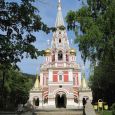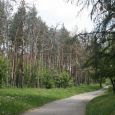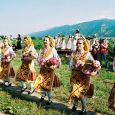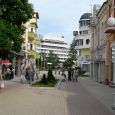Kazanlak
Advertisement
By Air
The airport of Kazanlak is situated very close to the city, near the village Ovoshtnik.
By Train
railway station Kazanlak the railway stations are situated across each other south of the city centre.Local buses 4 and 6 will take you into the centre, otherwise it wouldn't take more than 5 - 10 min to walk.Kazanluk is situated about halfway on the Sofia-Burgas line.Three trains per day travel into each direction.
By Bus
In Kazanlak urban transport is primarily by bus.Four bus lines serve the citizens of the municipality (1,11,12 and 13).Several buses carrying people from the villages and settlements of other municipalities to Kazanlak.
Iskra Town History Museum
The Iskra Town History Museum is one of the first provincial town museums in Bulgaria. It was founded on June 29, 1901, by Peter Topuzov — a bright man of enterprise from Kazanlak and by decision of the leaders of Iskra Studious Club. More than 50 000 exhibits revealing the history of Kazanlak area from ancient times until nowadays have been kept at Iskra museum. The finds from Thracian town of Seuthopolis are displayed in three separate halls. Temporary exhibitions with valuable articles from this museum and loan-collections are arranged during the active tourist season.
Buzludzha National Park
Buzludzha National Park rises east of the Shipka pass. It is a very important part of Bulgarian history — here, on July 30, 1868, Hadzhi Dimitar fell in battle. He was at the head of a small group of rebels fighting the numerous Turkish enemy. In 1961 a monument was built here to commemorate this act of heroism. The impressive marble figure of Hadji Dimiter is outlined against the green background of the pine-trees. Near it, under the venerable beeches, a stone bas relief commemorates another event in Bulgarian history — founding of the Bulgarian Socialist Party on August 2, 1891, after a clandestine congress. Buzludzha with its numerous chalets, rest homes and hotels offers excellent opportunities for the lovers of winter sports and tourism.
The Buzovgrad megalith
The Buzovdrad megalithic formation is located in the foot of the Sredna Gora mountains near the village of Buzovgrad, 5 km south of Kazanlak. The site was described as a thracian sanctuary by the renowned thracologist Alexander Fol. According to his estimations the Buzovgrad megalith was used as a rock sanctuary around 1800 - 1600 BOT. According to thracian religious beliefs, sunrise is a symbol of birth and creation, and sunset reflects death and the world of the dead. In that context, people believed that the sanctuary represented “a door leading to another world”. It is thought to have been used for religious rituals and for the funerals of Thracian aristocrats and priests. Alexander Fol himself described the sight as the Solar gate or the Gate of the Mother Goddess.
The Shipka Memorial Church
is located only 12 km (7.5 mi) north of Kazanlak, at the south foot of the Stara Planina mountains near the town of Shipka. It was erected after Bulgarian independence as a monument to both Russian and Bulgarian dead. The golden domes and the green and pink coloured facade loom against the mountains and attract the attention of the travellers in the Shipka pass. The project design following the seventeen-century Russian church architecture with arks, friezes, pediments, and gold-plated ornaments, was the work of the Czech architect A.I. Tomisko. The main entrance has three arks, topped off with the distinctive 50-metre (160 ft) high spire of the bell tower. There are 17 bells, the heaviest of them weighs about 12 metric tons (12 long tons; 13 short tons). The lime-tree iconostasis is richly decorated with gilded wood-carvings and is of great artistic value.
The Kosmatka Tomb
The Kosmatka Tomb represents a remarkable Thracian heroon built accordingly to the Orphic traditions of the end of the 5th or beginning of the 4th century BOT. Serving also as a symbolic tomb of Seuthes III, it contained an enormous treasure, exhibited now in the Iskra Museum and Art Gallery. More than 70 silver, gold and bronze objects, which were used as ritual offering to the gods, were discovered during the excavations.The temple was used between the end of the fifth and the beginning of the third century BOT, when a symbolic burial ceremony of Seuthes III took place, the famous founder of the Thracian city of Seuthopolis, located only 10 km (6.2 mi) away. After the symbolic burial ceremony, the temple was closed and the entrance sealed and buried.
Rose Festival
The Rose Festival is one of the most remarkable events in Bulgaria, dedicated to beauty and flowers, to spring and the fragrance of the priceless Kazanlak rose. The beautiful celebrations for the blossom of the roses there takes place in the first week of June. The whole week is filled with different attractions every day. That week is also interesting, because there is a beauty pageant and on the last day of the celebrations, the most beautiful girl in the city is chosen. They call her "The Queen Of Roses". The Rose Festival was celebrated for the first time in 1903 and since then it has traditionally been held during the first weekend of June. This is the season when the gentle oleaginous Kazanlak rose comes to bloom, filling the air with its scent. Nowadays the Rose Festival has evolved into an international event where thousands of tourists and guests of the town are entertained.
Shipka National Park
Shipka National Park is founded on the same area where the bloody battles of the Russian-Turkish Liberation War occurred during 1870s. It represents a complex of memorial tablets, monuments, trenches, and bunkers reminiscent of the battle.On the top of the mount at Shipka rises the "Freedom Monument". It was paid for by voluntary donations of the Bulgarian people and built after the design of Atanas Donkov, an architect and Alexander Andreev, a sculptor. The monument was opened officially in 1934. The located on the monument's levels expositions relate the story of Russian soldiers' and Bulgarian volunteers' heroism during the five-month defence of the pass. From the last ground there is a panorama of the restored details of the battle field, monuments and common graves reminiscent of the self-sacrifice of the Russian and Bulgarian heroes.The locality offers excellent conditions for relaxation and tourism. Several shops, cafes with well stocked wet-bar, camping, a comfortable hotel-restaurant and a petrol station are available for the visitors.The national Shipka-Buzludza park-museum includes Shipka Memorial Church (or Church of the Nativity) near the town of Shipka, Shipka National Park, Freedom Monument near the village of Sheinovo and Buzludza National Park.
Koulata Ethnographic Complex
The charming cobbled Mirska Street is located in the oldest part of the city Koulata District, which is near the world-famous Thracian Tomb of Kazanlak. This is where traditional architecture from the period of the Bulgarian National Revival (18th – 19th centurty) can be found. The traditional buildings there constitute Koulata Ethnographic Complex, restored and open to visitors since 1976. They “take us back” to the unique, diverse material culture of Bulgarians from the Kazanlak region of the past.Before stepping through the big gate, one can hear the clanking of the coppersmiths’ hammers in the distance.Their “song” tells the storey of the typical local coppersmiths craft.Just opposite are the violin-makers and right next door is the goldsmith’s.The country house nestles among bushes and trees.It is one-storied, asymmetrical and in architectural terms has the characteristic of the Balkan velley houses from the end of the 18th and the beginning of the 19th century.The life-style of the late 19th and early 20th century inhabitants of the region is shown in the restored houses from the time of the Bulgarian Renaissance.
April - August
December - February






